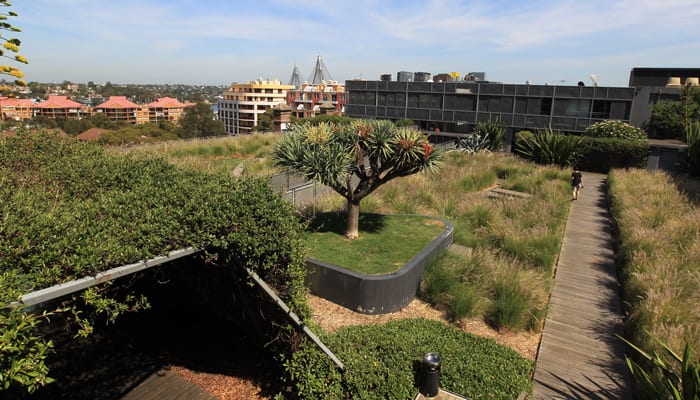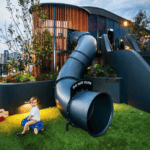
10 Mar Green Roofs – Green islands in the city sky
Featured image: Rooftop garden Harris street Pyrmont NSW – Photo by Tamara Dean
Waterproofing and Structural Design Considerations for Green Roofs
A green roof brings a wealth of benefits when it is skillfully designed, soundly constructed within the load-bearing capacity and has a waterproofing system in excellent condition.

Valencia Residences – Aria Property Group – Rooftop kids retreat at the award-winning Valencia Residences, part of StrataCare Australia.
Green roofs, rooftop gardens, eco-roofs or living roof systems, are continuing to grow in popularity not only in Europe and the USA, but are also starting to set roots in Australia as a move towards a vision of creating cleaner, greener, more eco-friendly and sustainable cities. A green roof, especially a rooftop garden, is a highly valued beautiful and green recreational communal oasis above the urban landscape that provides economic, social, health and wellbeing benefits. These green roofs are typically found in high-end commercial and residential urban developments, but green roofs are slowly starting to appear atop individual homes too.
Are you are playing with the idea of installing a green roof on an existing commercial or residential building?
If you already have had the roof and load-bearing walls tested by a structural engineer and the weight-bearing capacity is confirmed to be able to support the additional load of a green roof, the next very important step is to have your waterproofing system thoroughly checked for defects and leaks, remediated if any leaks are detected and re-tested after repairs prior to the installation of a growing substrate.
Because a leak can travel far from its source, finding the origin of a leak can be challenging. Engaging a reputable leak detector company that uses electronic charges to trace the path of the leak to its source is recommended. Electric Field Vector Mapping (EFVM) is very accurate and able to effectively identify leaking pinholes in the waterproof membrane that may be visually too small to find by traditional flood testing. Leak detection and the repair of leaks may present a much greater challenge once the growing substrate and vegetation are installed. That is why installing a leak detection and moisture system such as a conductive vector mapping medium grid may also be worth your while looking into as it will aid in pinpointing the leak’s source if it occurs after the green roof has been installed. Otherwise, a non-destructive leak detection may not be practicable.
It is crucial to ensure that the roof’s waterproof membrane system is of high quality and suitable for its intended purpose. If you need to install a new waterproof membrane, it is recommended that you consider the option of installing a tough, flexible and certified root-resistant waterproof membrane to help prevent roots from growing through the roof membrane.
As an alternative, if the waterproofing membrane does not include a root-resistant component, a membrane protection and protective root barrier system can be laid over the green-roof-suitable membrane during the installation of the growing substrate to provide protection to the waterproofing membrane. However, be mindful if choosing to use a root-resistant foil (that usually is made out of 0.2 to 0.4 mm thick polyethylene), as it has the potential of trapping water between the foil and the waterproof membrane. Firstly, this could draw the roots towards the membrane. When the roots start growing between the root-protective sheet and the waterproof membrane, the membrane is faced with a great risk of rupturing, which in turn will likely lead to water ingress to the roof structure if left untreated. Secondly, accumulated water trapped between the root-resistant foil and the membrane may shorten the waterproof membrane’s life expectancy and leaks will likely occur.
Benefits of a green roof
Besides providing an aesthetically pleasing rooftop landscape for socialising and recreation, a green roof can offer the following environmental and economic benefits by:
- Reducing urban air temperature by protecting the building from direct solar heat as it provides shading of the outer surface of the building (roof). It works as a very effective insulation. Traditional roofing materials, on the other hand, absorb and retain the sun’s heat in the buildings, which contribute to the creation of a so-called urban heat island effect.
- Helping improve air quality as plants and vegetation act as filters of gaseous contaminants and particulate matter in the air, thus reducing the concentrations of atmospheric pollutants. The plants’ process of photosynthesis helps decreasing the carbon dioxide in the air and increasing the amount of oxygen in the air.
- Regulating the indoor temperature due to passive cooling from the natural insulation, which reduces energy consumption as a result of the evapotranspiration cooling effect of the plants. Green roofs also help to insulate against heat loss in winter. This means that less energy and money is spent on heating in winter and air conditioning usage in summer.
- Absorbing stormwater thus helping slow down the peak discharge flow rate into the stormwater drainage system, thus reducing the risk of flash flooding.
- Facilitating ecological benefits of birds, bees and other insects.
- Protecting the roofing membrane and increasing its longevity. Conventional roofing systems are typically replaced every 20 to 30 years. A properly installed and maintained green roof may extend the life of the roof 2-3 times its normal life.
- Reducing noise by absorbing sound in the growing medium and vegetation.
Disadvantages of a green roof
With all the above-mentioned benefits, the disadvantages are few but important to note:
Structural limitations: A green roof such as a rooftop garden can be heavy, so the load-bearing capacity of a building must be known before planning a green roof. A rooftop vegetation system can weigh between 60-500 kg/sqm or more depending on whether it is classified as an “extensive green roof” or an “intensive green roof”.
An “intensive green roof” will require a strong physical roof structure that may be difficult to retrofit existing buildings, whilst an “extensive green roof” may be relatively easy to retrofit on existing roofs. An intensive green roof has a thicker growing medium than an extensive green roof and has greater water holding capacity and can support a wider variety of plants and shrubs.
Damage from leaks: Waterproofing must be protected from root penetration. Sometimes, despite a root barrier system, the roots of plants can penetrate the waterproof membrane causing water leaks that if left undetected and untreated can result in structural damage. A green roof may make it more difficult to locate any leaks in the waterproofing system.
Cost: They have higher initial costs because of the additional material needed and high installation costs.
Maintenance: They require higher maintenance for plant care and upkeep until plants are fully established and the roof is fully covered (about two years). Some ongoing maintenance is also required. A regular inspection is needed to remove unwanted vegetation that could cause problems. This will help reduce the potential for developing leaks.
Is the existing waterproofing system on your roof able to support a green roof system? Wondering if it is the correct type suited for a green roof? Our Waterstop Solutions team of experts can help you find the best waterproofing system and solution tailored to specific performance requirements.
Our team thrive on finding solutions through in-house R&D and by networking with our skilful suppliers and other industry professionals. Tricky waterproofing challenges are what sets us apart in the remedial waterproofing industry – backed by the 60+ years combined experience of Waterstop Solutions directors Harold Du Toit and Chris Anderson, master leak sealing technicians and management team.
If you have any issues with water ingress, rooftop leaks, leaking balcony, leaking basement, cracking concrete slabs, structural cracks, concrete deterioration, spalling concrete, concrete cancer, deteriorated joints, moisture, seepage, efflorescence, rising damp and/or high-flow active leaks in concrete structures, we would be happy to assist you. You are welcome to contact us with any questions that you may have.
Brisbane office: (07) 3205 1899
Email: [email protected]
Sydney office: (02) 9346 8308
Email: [email protected]
Are you interested in finding out more about the various remedial building services we are providing?
Please click on the image below to download Waterstop Solutions Capability Statement
Waterstop Solutions Capability Statement is now available to download as PDF. (The image is clickable and opens up a link to our Capability Statement).
Good maintenance begins with a proactive approach to maintain, keep, preserve and protect a building.
Remember that seepage/water ingress into areas such as balconies, basements, concrete roofs, car parks and retaining walls, should not be ignored – call a remedial waterproofing professional today for an assessment to provide you with the best solution for your situation.
At Waterstop Solutions, we carry out a wide range of remedial works to concrete structures post-construction stage in Brisbane, Gold Coast, Sunshine Coast, Sydney and outlying areas in Queensland and New South Wales.
Equipped with major civil works experience, we can quickly determine the best approach to rectify all seepage and concrete deterioration issues.
It takes licenced remedial waterproofer and leak sealing experts like us at Waterstop Solutions to ensure that the pathways for water to ingress are properly sealed off. A depth of technical knowledge and experience, along with a proud reputation for integrity and reliability, has made Waterstop Solutions the go-to company for many Defect Managers working for major construction companies across Queensland and New South Wales.
We at Waterstop Solutions have the technical and practical expertise to diagnose the source of the leak and will provide you with our recommended solution to achieving an effective, high-quality, long-lasting repair to stop the water ingress with minimal disruption
We believe in and are committed to always delivering high-quality solutions by utilising the right products and techniques for each specific project combined with our industry-leading know-how on tap. We have a large talent pool of specialist leak sealing and concrete repair technicians with Certificate III in construction waterproofing in Queensland and New South Wales that are extensively trained in our systems and project execution methods.
The leadership positions on every Waterstop Solutions project are operated by highly qualified, certified and experienced industry professionals. Our in-house skills and expertise gained from more than 60 years of industry experience provide a full range of high-quality remedial waterproofing and concrete repair works to commercial buildings, civil infrastructures, industrial sites and residential properties. From waterproofing diagnostics, preventative and remediation solutions – All of our waterproofing solutions are quality guaranteed.


